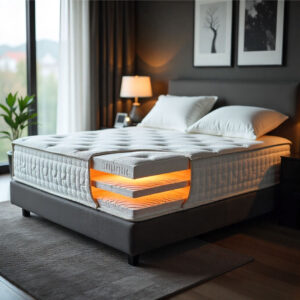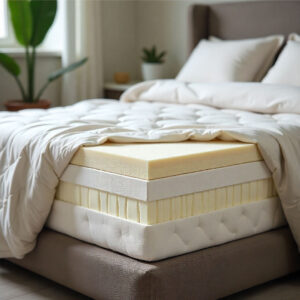When it comes to getting a good night’s sleep, the mattress you choose plays a crucial role. Among the wide variety of mattress types, a plush mattress is often regarded as one of the most comfortable options for those who crave softness and luxury. But what exactly is a plush mattress, and how does it differ from other types of mattresses? In this detailed guide, we will walk you through everything you need to know about plush mattresses, including their features, benefits, and how to choose the best one for you. Let’s dive into the plush mattress world and find out why it’s the top choice for many.
A plush mattress refers to a mattress that features a soft and cushioned feel, typically designed to provide a gentle and luxurious sleeping experience. The primary characteristic of a plush mattress is its soft comfort layer, which provides a cloud-like sensation when you lie down. This layer, often made from memory foam, latex, or other soft materials, helps to relieve pressure points, contouring to your body’s natural shape.
Plush mattresses are often confused with medium-firm or firm mattresses, but the key difference lies in the softness level. A plush mattress is designed for those who prefer a more cushioned, softer surface. It’s perfect for side sleepers, people with joint pain, or anyone who enjoys a more luxurious, “sink-in” feel during sleep.
Plush Mattress vs. Firm Mattress Comfort and Support Differences

Understanding the difference between a plush and firm mattress can be essential in making the right choice for your sleeping needs. Here’s a breakdown of how the two compare:
-
Plush Mattress: A plush mattress provides a soft, cushioning feel with thick layers of foam or padding. It conforms to the body, relieving pressure points and ensuring a more comfortable sleep experience. Ideal for side sleepers and people who prefer a softer feel, a plush mattress helps alleviate tension on the hips and shoulders.
-
Firm Mattress: In contrast, a firm mattress has less cushioning and provides a solid, supportive base. While it’s perfect for stomach sleepers or those who require extra back support, it doesn’t offer the same level of softness and comfort as a plush mattress. A firm mattress is designed to maintain spinal alignment, but it may feel too hard for individuals who prefer a cushioned sleeping surface.
Benefits of a Plush Mattress
A plush mattress offers several advantages that can significantly improve your sleep quality and overall health. Here are some of the top benefits of choosing a plush mattress:
1. Exceptional Comfort and Softness
The most significant advantage of a plush mattress is its luxurious comfort. The soft, cushioned surface provides a cozy feeling, perfect for those who enjoy sinking into their bed at the end of the day. Plush mattresses have layers of foam or other soft materials that create a plush, gentle sleeping experience.
2. Pressure Relief
A plush mattress is known for pressure relief, especially for individuals who experience pain in sensitive areas, such as the hips, shoulders, and lower back. The extra cushioning allows the body to sink into the mattress slightly, reducing the pressure on these key areas and helping to relieve pain and discomfort during sleep.
3. Ideal for Side Sleepers
If you’re a side sleeper, a plush mattress is one of the best options. When you sleep on your side, pressure tends to build up around your shoulders and hips. A plush mattress helps to relieve this pressure by conforming to your body, ensuring that your spine remains aligned while reducing the risk of discomfort.
4. Improved Sleep Quality
The soft, plush surface encourages better sleep quality. When your body feels comfortable and supported, it’s less likely to shift positions throughout the night. Plush mattresses are particularly beneficial for individuals who tend to toss and turn, ensuring a comfortable and undisturbed night’s sleep.
5. Motion Isolation
If you share a bed with a partner, a plush mattress can help minimize motion transfer. Memory foam and hybrid plush mattresses excel at isolating movement, meaning that when your partner moves, you won’t feel the disturbances as much. This feature is ideal for light sleepers or couples who share a bed.
When comparing plush and firm mattresses, one of the most noticeable differences lies in the balance of comfort and support. A plush mattress is designed with multiple cushioning layers, often including memory foam, latex, or pillow tops. These create a soft, cloud-like feel that allows your body to sink slightly into the surface. This contouring effect relieves pressure points in areas like the shoulders and hips, making plush mattresses an excellent option for side sleepers or individuals who prefer a more cushioned sleep environment. The comfort comes from its ability to cradle the body while still offering underlying support.
In contrast, firm mattresses offer a sturdier and more solid sleeping surface. Instead of allowing deep sinkage, they keep your body lifted and aligned, preventing excessive curvature of the spine. This makes firm options particularly beneficial for back and stomach sleepers, as well as heavier individuals who may require extra support to maintain proper posture during sleep. The support of a firm mattress helps distribute body weight evenly, reducing strain on the back and enhancing overall spinal alignment.
Soft, Cushion-Like Feel of Plush Beds

Plush mattresses are well-known for their soft, cushion-like feel that creates a cozy, cradling sleep experience. Unlike firmer options, plush beds are crafted with thick comfort layers made of materials like memory foam, latex, or quilted pillow tops. These layers gently contour around the body, providing a “sink-in” sensation that many sleepers find luxuriously comfortable. The softness is especially noticeable for those who enjoy feeling enveloped by their bed rather than resting on top of it.
One of the main benefits of a plush mattress is its ability to relieve pressure points. Side sleepers, in particular, benefit from this cushioned support because it reduces strain on the shoulders and hips, which often bear the most weight during the night. Lightweight sleepers also find plush beds more comfortable, as the mattress easily adjusts to their body shape without feeling overly rigid.
The cushion-like quality of plush mattresses promotes relaxation by reducing tossing and turning. The gentle hug of the surface can help calm muscles and create a sense of weightlessness, which is ideal for anyone seeking a restful and soothing sleep environment. While plush beds emphasize softness, most modern designs strike a balance between comfort and a supportive core, ensuring that the spine remains aligned.
What Materials Are Used in Plush Mattresses

Plush mattresses come in a variety of materials, each offering unique benefits. Some common materials used in plush mattresses include:
-
Memory Foam: Memory foam is a popular material used in plush mattresses for its ability to contour to the body. It offers exceptional pressure relief and motion isolation, making it a top choice for many sleepers.
-
Latex: Latex is a natural material known for its resilience and soft feel. It provides a bouncy yet supportive surface and is naturally hypoallergenic, making it a great choice for those with allergies.
-
Innerspring: Innerspring mattresses are made with coils that provide support and structure. When combined with a plush comfort layer, they offer a balance of cushioning and support, ideal for sleepers who want both softness and durability.
-
Hybrid: Hybrid mattresses combine the benefits of both innerspring coils and foam layers. The innerspring coils provide support while the foam layers offer plush cushioning. Hybrid mattresses can be an excellent choice for sleepers looking for a balance of comfort and support.
How to Choose the Right Plush Mattress for You

Choosing the right plush mattress is key to ensuring a restful and rejuvenating sleep. Here are some tips to help you make the right decision:
1. Consider Your Sleeping Position
-
Side Sleepers: A plush mattress is often the best option for side sleepers, as it provides cushioning for the shoulders and hips.
-
Back Sleepers: A medium-firm or firm mattress may be better for back sleepers who need extra support for spinal alignment.
-
Stomach Sleepers: Stomach sleepers often require a firm mattress to prevent the spine from sinking too much, which can lead to misalignment.
2. Determine Your Budget
Plush mattresses can vary in price depending on the materials and brand. While high-end luxury models can be expensive, there are also affordable options that offer great comfort and support. Determine your budget and look for a mattress that fits within it while meeting your comfort needs.
3. Check for a Trial Period
Many mattress companies offer trial periods that allow you to test out the mattress at home. This is especially important with plush mattresses, as it gives you a chance to ensure that the mattress is soft enough to meet your expectations. If you’re not satisfied, you can typically return the mattress within the trial period.
4. Read Customer Reviews
Reading customer reviews is one of the best ways to determine if a plush mattress will suit your needs. Look for feedback from people who have similar preferences and sleeping habits to gain a better understanding of the mattress’s comfort level and durability.
Conclusion: Is a Plush Mattress Right for You
A plush mattress offers unmatched softness and comfort, making it an ideal choice for side sleepers, individuals with joint pain, or anyone who enjoys a luxurious, cloud-like feel when they sleep. With its ability to relieve pressure points, promote better sleep quality, and minimize motion transfer, a plush mattress can significantly improve your sleep experience.
When choosing a plush mattress, make sure to consider factors like your sleeping position, the materials used, and your budget. If you’re ready to experience the ultimate in comfort, a plush mattress might be the perfect investment for better sleep and a refreshed morning.
